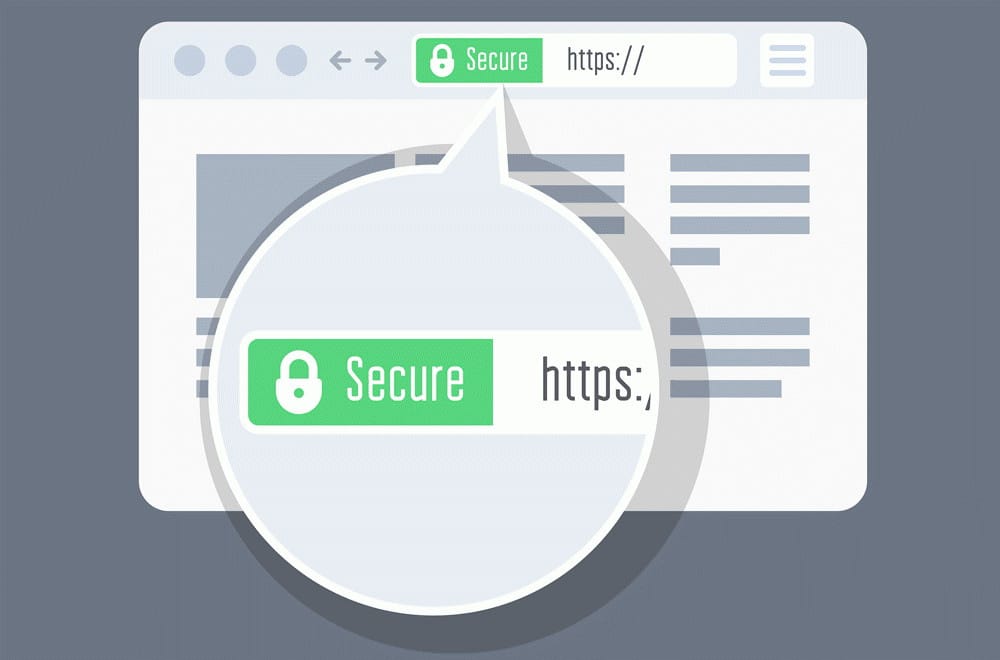What Are Fake Websites?
Fake websites are designed to look authentic but serve malicious purposes, such as stealing login credentials or installing harmful software. They often mimic well-known brands or organizations by using misleading logos, similar layouts, and web addresses that appear legitimate at a glance. Giveaways of fake sites can include poor design quality, excessive pop-ups, and suspicious payment methods. Paying close attention to these details can help you avoid inadvertently sharing sensitive information with cybercriminals.
How to Check If a Website Is Safe
Check the URL
Look closely at the site’s web address. Legitimate URLs generally don’t include strange characters or spelling mistakes. Watch for subtle variations like extra letters or swapped characters, which could indicate you’re on a spoofed version of an otherwise authentic domain.
Check for HTTPS
Web addresses that start with “HTTPS” and display a padlock icon in the address bar use an encrypted connection. While HTTPS is an important security measure, it alone doesn’t guarantee that a site is trustworthy — so always check for other indicators, too.
Use a Website Safety Checker
Various tools can help confirm if a site has been flagged for harmful activity, such as phishing or malware. Simply enter the suspicious URL to discover if it’s on any blacklist or if it’s been reported for malicious behavior.
Use Your Browser’s Safety Tools
Many browsers feature built-in protection against phishing and other threats, warning you when a visited site is deemed unsafe. These safety tools provide an extra level of reassurance during everyday web use.
Look for a Privacy Policy
Legitimate sites typically include a clear privacy policy to inform visitors about their data collection and usage. If a privacy policy is missing or hard to locate, it’s a red flag that the site may not be reliable.
Look for an SSL Certificate
When a website holds a valid SSL certificate, it encrypts sensitive data like payment or login details. This encryption shows up as “HTTPS” in the address bar with a padlock icon. Sites lacking valid SSL certificates jeopardize your information.
Make Sure the Site Is Real
Legitimate websites often feature quality content, a professional layout, and minimal errors. If you see poor grammar, broken links, or substandard visuals, the site might be compromised or fake.
Read Reviews of the Site
Online reviews offer direct insights from other users. Trusted forums and review platforms can quickly reveal complaints, especially if many people have encountered scams or poor service.
Search for Contact Information
Most genuine enterprises display phone numbers, email addresses, or physical addresses. If basic contact information is missing, reconsider sharing personal or financial data on that website.
Use Web Security Tools
Software and plug-ins that screen for malicious sites add an extra protective layer. They scan for recognized malware signatures, phishing attempts, and other threats, often blocking harmful sites before you can load them.
9 Signs That a Website Is Fake
-
Excessive pop-ups or redirects
-
Overt spelling and grammar mistakes
-
Strange or unverified URLs
-
Missing refund policies or customer support details
-
No “About Us” page
-
Unrealistic deals or discounts
-
Sketchy payment methods
-
Low-quality images or random logos
-
No active social media presence
3 Common Questions & Answers
How do fake or scam websites work?
They typically pose as real sites to trick visitors into sharing personal data or downloading malware. Scammers often rely on convincing visuals, bogus payment channels, or too-good-to-be-true offers.
How do you verify if a website is safe?
Inspect the URL carefully, confirm it’s secured by HTTPS, read available reviews, and use a website safety scanner. Also, verify that the site’s design quality and writing aren’t filled with errors.
How do I know if a website is credible?
Credible sites feature professional layouts, valid SSL certificates, and transparent policies. They normally include easily accessible contact details and have been positively reviewed by other users.

